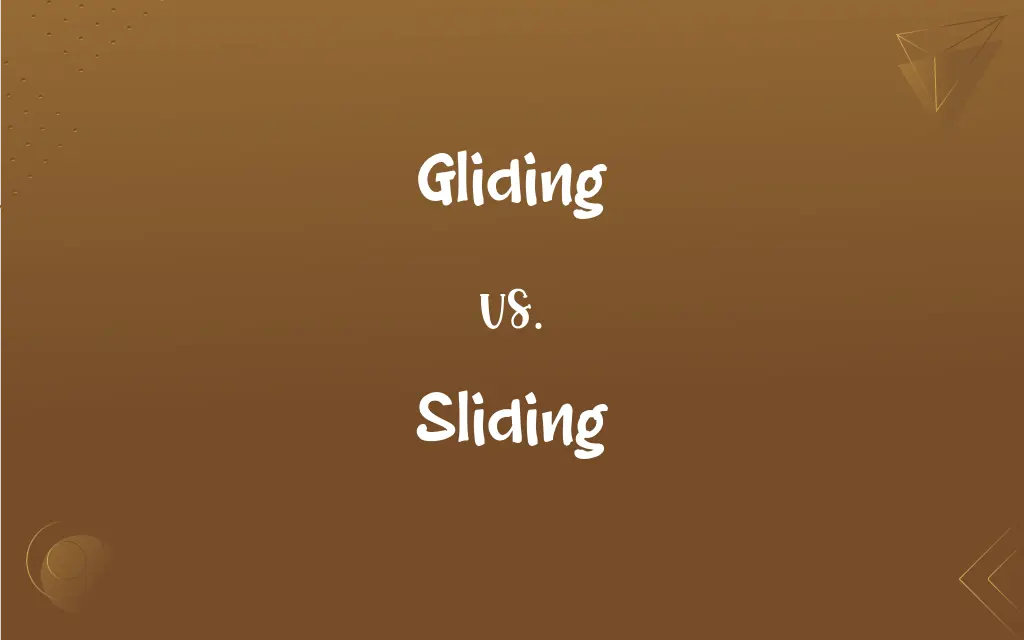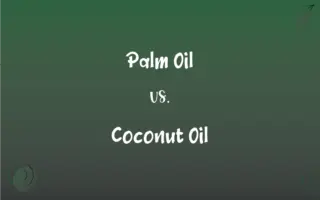Gliding vs. Sliding: What's the Difference?
Edited by Aimie Carlson || By Janet White || Published on December 7, 2023
Gliding refers to smooth, continuous motion through air or over a surface, often with minimal contact. Sliding refers to movement along a surface, typically involving continuous contact and friction.

Key Differences
Gliding refers to a type of motion that is smooth and often effortless, where an object or entity moves continuously through the air or over a surface with minimal resistance. Sliding, in contrast, is a movement along a surface where there is direct and continuous contact, usually accompanied by friction, between the moving object and the surface.
The term gliding is often used in contexts such as flying or moving through water, where the movement is graceful and fluid, with little to no propulsion or force being applied once in motion. Sliding typically involves a push or force at the beginning and is characterized by the object remaining in contact with the surface, as seen in activities like sliding on ice or down a slide.
In gliding, the interaction between the object and the surface or medium it moves through is minimal, often relying on aerodynamics or buoyancy. For sliding, the interaction is more pronounced, with friction playing a significant role in the movement, affecting both speed and control.
Gliding can be seen in activities like hang gliding or ice skating, where the movement is sustained over a period with little resistance. In contrast, sliding is evident in actions such as sliding a box across the floor or a child sliding down a playground slide, where the motion is directly reliant on the surface contact.
Gliding is often associated with a sense of control and stability during the movement, while sliding can sometimes result in less control due to the friction and potential for sudden stops or changes in direction.
ADVERTISEMENT
Comparison Chart
Type of Movement
Smooth, continuous
Along a surface with contact
Surface Interaction
Minimal contact
Continuous contact and friction
Common Contexts
Air or water movement
Movement on solid surfaces
Control and Stability
More controlled and stable
Can be less controlled
Examples
Hang gliding, ice skating
Sliding on ice, playground slides
ADVERTISEMENT
Gliding and Sliding Definitions
Gliding
The act of moving smoothly and continuously, often in air or water.
She enjoyed gliding in the calm waters of the lake.
Sliding
The act of moving smoothly over a surface, typically with direct contact.
She was sliding the box across the floor.
Gliding
Moving in a steady and smooth manner, especially in flying or swimming.
Dolphins are known for their ability to glide elegantly through water.
Sliding
A form of movement where an object or person moves along a surface, like ice or ground.
Ice makes the sidewalks slippery, causing people to slide.
Gliding
Movement through air or water with smooth, sustained motion.
The eagle was gliding effortlessly through the sky.
Sliding
Movement along a surface with continuous contact, often encountering friction.
The child was sliding down the snowy hill on a sled.
Gliding
A type of flight or motion with minimal propulsion or resistance.
The glider was gliding gracefully over the countryside.
Sliding
To move along a surface without lifting, often losing some control.
The car started sliding on the icy road.
Gliding
Effortless movement across a surface, like ice or air, often used in sports.
The skater was gliding across the ice with ease.
Sliding
Slipping or moving over a surface in a continuous motion, typically used in sports or play.
The baseball player was sliding into home base.
Gliding
To move in a smooth, effortless manner
A submarine gliding through the water.
Sliding
To move over a surface while maintaining smooth continuous contact.
Gliding
To move silently and furtively
The thief glided across the room.
Sliding
To participate in a sport that involves such movement
Sliding for a medal in luge.
Gliding
To occur or pass imperceptibly
The autumn days glided by.
FAQs
What does sliding mean?
Movement along a surface with continuous contact and often friction.
Can sliding occur on any surface?
Yes, but it's more common on smooth or slippery surfaces like ice or polished floors.
What is gliding?
Moving smoothly through air or over a surface, often with minimal contact.
What role does friction play in sliding?
Friction is a key factor, affecting the speed and control of the sliding motion.
Can sliding lead to a loss of control?
Yes, especially on very slippery surfaces or at high speeds.
Where is gliding commonly seen?
In air and water sports, like hang gliding or swimming.
How does the surface affect gliding?
The surface needs to allow for minimal resistance, like air or water.
Are gliding movements always controlled?
Typically, yes, gliding is associated with stability and control.
Is propulsion required for gliding?
Minimal propulsion is needed once in motion; it's more about sustained, smooth movement.
Are there sports that involve sliding?
Yes, sports like baseball often include sliding actions.
Can gliding be used in transportation?
Yes, in forms like hang gliding or glider aircraft.
Is sliding always intentional?
Not always; it can be accidental, especially on slippery surfaces.
How does weight affect sliding?
Heavier objects may slide faster or with more momentum due to gravity and friction.
Is sliding common in everyday life?
Yes, common in simple actions like sliding a drawer or slipping on ice.
What are examples of gliding in nature?
Birds like eagles gliding in the sky or fish gliding in water.
Do sports incorporate gliding?
Yes, sports like ice skating and skiing involve gliding movements.
Are special skills required for gliding?
Yes, skills like balance and aerodynamic understanding are often needed.
What surfaces are best for sliding?
Smooth and often slippery surfaces, like ice or polished floors.
Is gliding energy-efficient?
Yes, it can be quite energy-efficient due to minimal resistance.
Do different materials affect sliding?
Yes, the material of both the surface and the object influences the ease and control of sliding.
About Author
Written by
Janet WhiteJanet White has been an esteemed writer and blogger for Difference Wiki. Holding a Master's degree in Science and Medical Journalism from the prestigious Boston University, she has consistently demonstrated her expertise and passion for her field. When she's not immersed in her work, Janet relishes her time exercising, delving into a good book, and cherishing moments with friends and family.
Edited by
Aimie CarlsonAimie Carlson, holding a master's degree in English literature, is a fervent English language enthusiast. She lends her writing talents to Difference Wiki, a prominent website that specializes in comparisons, offering readers insightful analyses that both captivate and inform.






































































